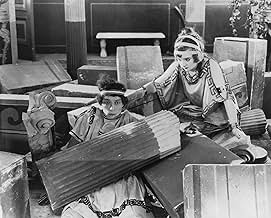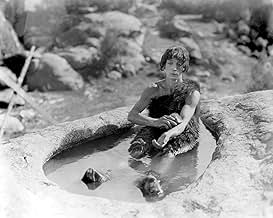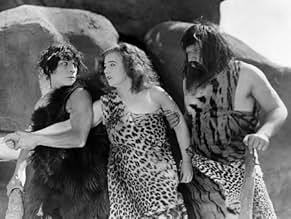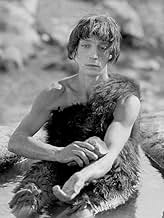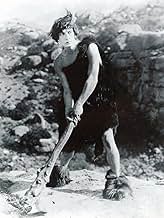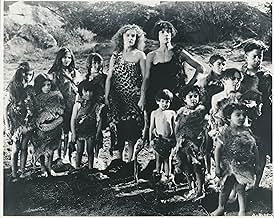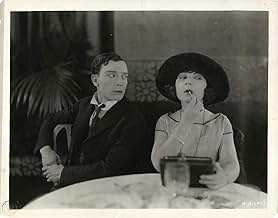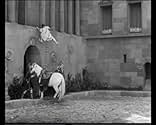VALUTAZIONE IMDb
7,0/10
5606
LA TUA VALUTAZIONE
Aggiungi una trama nella tua linguaThe misadventures of Buster in three separate historical periods.The misadventures of Buster in three separate historical periods.The misadventures of Buster in three separate historical periods.
- Regia
- Sceneggiatura
- Star
- Premi
- 1 candidatura in totale
Kewpie Morgan
- The Emperor
- (as Horace Morgan)
- …
Lionel Belmore
- Undetermined Role
- (partecipazione non confermata)
- (non citato nei titoli originali)
Bernard Berger
- Roman-age child
- (non citato nei titoli originali)
Basil Bookasta
- Stone Age Child
- (non citato nei titoli originali)
George Bookasta
- Stone Age Child
- (non citato nei titoli originali)
George Davis
- Roman Guard Knocked Down
- (non citato nei titoli originali)
Louise Emmons
- Old Fortune Teller
- (non citato nei titoli originali)
F.F. Guenste
- Butler
- (non citato nei titoli originali)
Blanche Payson
- The Amazon
- (non citato nei titoli originali)
Recensioni in evidenza
The more time I spend with old films, the more of a giant I see Keaton to be. I'm beginning to think that we all need to see a lot of him, which is why I wandered into this. It seems to have been made only because they had access to a Roman set.
The setup is that a courtship story is presented in three eras: a cave-man setup, a Roman context and a modern one. All are based on film notions of those eras of course. Unlike most movie humor of the time, the joke here isn't in embellishing the story with humorous decoration. Its in the difference among the stories.
Its a clever piece of what I call folding, and you will see at least one scene here that I swear is quoted in "Rashomon."
So there's the idea of the thing, which is worthwhile, but now I've explained it, you hardly have to see it. The jokes are trite. But there is one scene that I recall over and over. I think Keaton did it elsewhere and several others too, but here it is the best.
He's driving a car, a rickety one to his girl's house. (This is in the modern setting, obviously.) He hits a bump and the car falls to pieces. And I just don't mean the wheels fall off, the car quite literally disassembles into the parts that went into the factory and there he sits among hundreds of items. I have no idea how he did this. The car really is moving as a car, and then in an instant it is in pieces.
Wonderful.
Ted's Evaluation -- 3 of 3: Worth watching.
The setup is that a courtship story is presented in three eras: a cave-man setup, a Roman context and a modern one. All are based on film notions of those eras of course. Unlike most movie humor of the time, the joke here isn't in embellishing the story with humorous decoration. Its in the difference among the stories.
Its a clever piece of what I call folding, and you will see at least one scene here that I swear is quoted in "Rashomon."
So there's the idea of the thing, which is worthwhile, but now I've explained it, you hardly have to see it. The jokes are trite. But there is one scene that I recall over and over. I think Keaton did it elsewhere and several others too, but here it is the best.
He's driving a car, a rickety one to his girl's house. (This is in the modern setting, obviously.) He hits a bump and the car falls to pieces. And I just don't mean the wheels fall off, the car quite literally disassembles into the parts that went into the factory and there he sits among hundreds of items. I have no idea how he did this. The car really is moving as a car, and then in an instant it is in pieces.
Wonderful.
Ted's Evaluation -- 3 of 3: Worth watching.
I'd have to rate this as slightly above-average Keaton fare. It shows Buster trying to romance the girl away from Wallace Beery, and what would have transpired if the story had taken place in (1) the Stone Age; (2) The Roman Age, and (3) The Modern Age.
I liked them in that order, too, with more laughs with the older periods of time, although I laughed at the hardest at a couple of segments in the Roman Age. My favorite was the chariot race held in the sand. That had a number of clever things in the segment. The brief bit with the lion was funny, too, sort of a parody of the Biblical story of Daniel in the lion's den.
They were smart only going five minutes or so with each age and then going back with the story each time. Each "age" had four or five segments in total.
Nothing hilarious but definitely worth your time if you are checking out silent film comedies
I liked them in that order, too, with more laughs with the older periods of time, although I laughed at the hardest at a couple of segments in the Roman Age. My favorite was the chariot race held in the sand. That had a number of clever things in the segment. The brief bit with the lion was funny, too, sort of a parody of the Biblical story of Daniel in the lion's den.
They were smart only going five minutes or so with each age and then going back with the story each time. Each "age" had four or five segments in total.
Nothing hilarious but definitely worth your time if you are checking out silent film comedies
For me, Keaton's decision to make a parody of Griffith's Intolerance so that if the feature (his first) failed he could re-edit and release it as three two-reelers is what diminishes the enjoyment for me. The film jumps back and forth between the three time periods, and so all of them seem to be over before they've really begun, and the film has something of a disjointed feel. Perhaps this is because the film does actually feel as if it is three two-reelers spliced together rather than an actual feature.
The comedy is unevenly paced, but when it hits the mark it is near-perfect. Highlights include Keaton's drunken encounter with Wallace Beery, other diners, and a crab at a restaurant, and the jaw-dropping leap from one roof to another at what looks like hundreds of feet above the ground (apparently the buildings were short sets placed on a bridge overlooking a view of Los Angeles. Just as well, because Keaton failed to make the leap successfully and fell from the second building, a real-life mishap that remains in the film). Keaton slides through a window, across a room, down a pole (at this point we realise he is in a fire station although he doesn't) and lands on the back of a fire engine that returns him to the police station from which he has just escaped. The whole sequence is both side-splitting and astounding. The look on Keaton's face as he looks quizzically up at the pole he has just descended is priceless. Perhaps because of his status as a comic genius we tend to forget how good an actor Keaton was .
I liked the modern sequence best, and had it been released as a short I believe it would be considered one of his classics. The caveman sequence is OK, but the Roman era story tends to drag.
It's been well publicised that this was competition winner Margaret Leahy's only film because she was so untalented as an actress, and it's true she doesn't light any fires while on-screen. But the impact of her ineptitude in front of the camera is cleverly avoided by the likes of Keaton and Beery merely acting around her as if she were just another prop.
Overall, this isn't one of Keaton's best - although that is probably because this is his first feature. Keaton himself thought it was just OK and, given his instinctive sense for what works, perhaps that should tell us all we need to know...
The comedy is unevenly paced, but when it hits the mark it is near-perfect. Highlights include Keaton's drunken encounter with Wallace Beery, other diners, and a crab at a restaurant, and the jaw-dropping leap from one roof to another at what looks like hundreds of feet above the ground (apparently the buildings were short sets placed on a bridge overlooking a view of Los Angeles. Just as well, because Keaton failed to make the leap successfully and fell from the second building, a real-life mishap that remains in the film). Keaton slides through a window, across a room, down a pole (at this point we realise he is in a fire station although he doesn't) and lands on the back of a fire engine that returns him to the police station from which he has just escaped. The whole sequence is both side-splitting and astounding. The look on Keaton's face as he looks quizzically up at the pole he has just descended is priceless. Perhaps because of his status as a comic genius we tend to forget how good an actor Keaton was .
I liked the modern sequence best, and had it been released as a short I believe it would be considered one of his classics. The caveman sequence is OK, but the Roman era story tends to drag.
It's been well publicised that this was competition winner Margaret Leahy's only film because she was so untalented as an actress, and it's true she doesn't light any fires while on-screen. But the impact of her ineptitude in front of the camera is cleverly avoided by the likes of Keaton and Beery merely acting around her as if she were just another prop.
Overall, this isn't one of Keaton's best - although that is probably because this is his first feature. Keaton himself thought it was just OK and, given his instinctive sense for what works, perhaps that should tell us all we need to know...
First time of seeing Buster Keaton's first feature film and I have to admit I liked it a lot and only wish I'd stumbled across it years ago. The Rohauer blurb at the start warns that the Three Ages single nitrate print was rediscovered and salvaged in 1954 just in time before combustion, and many frames that seemed hopelessly glued together were separated. So, it's rocky viewing in places, but I've seen and survived much worse.
It would have been OK as the 3 short films but as a take on Intolerance it's inventive and funny from the start to the finish: In the Stone Age with baddie Wallace Beery riding an elephant and goodie Buster riding a pet brontosaurus; In the Roman Age Buster riding a chariot with wheel locks and adapted for sledging, No Parking signs in Latin; In this technological Age of Speed Need and Greed his car beautifully falls to bits at the first hump. Both him and Beery are after the Girl through the ages, a never ending tussle. Favourite bit: As the caveman he gets knocked backward over a cliff edge but still blows a kiss to the camera - an amazing second or two!
Great stuff, reaffirming my love of silent film comedy.
It would have been OK as the 3 short films but as a take on Intolerance it's inventive and funny from the start to the finish: In the Stone Age with baddie Wallace Beery riding an elephant and goodie Buster riding a pet brontosaurus; In the Roman Age Buster riding a chariot with wheel locks and adapted for sledging, No Parking signs in Latin; In this technological Age of Speed Need and Greed his car beautifully falls to bits at the first hump. Both him and Beery are after the Girl through the ages, a never ending tussle. Favourite bit: As the caveman he gets knocked backward over a cliff edge but still blows a kiss to the camera - an amazing second or two!
Great stuff, reaffirming my love of silent film comedy.
This is a pleasant and funny combination of slapstick and satire, period humor and romantic comedy. It does not have quite the number of sustained chase/stunt sequences as in most of Keaton's features, but instead there are a lot of fine subtle gags of all different kinds.
In each of the "Three Ages", Buster and Wallace Beery vie for the affections of the same woman, with amusing and unpredictable results. The simple romantic triangle theme sets up a lot of good material, on the one hand lending itself to a lot of gags about the unchanging nature of romantic courtship, and on the other hand being used for a lot of deliberate anachronisms that are often extremely funny. Beery makes a nice foil for Keaton, and the girl's parents also have some good moments.
This one usually gets lost in the crowd among so many brilliant Keaton masterpieces, but it works very well and is definitely worth seeing for any fan of silent comedy.
In each of the "Three Ages", Buster and Wallace Beery vie for the affections of the same woman, with amusing and unpredictable results. The simple romantic triangle theme sets up a lot of good material, on the one hand lending itself to a lot of gags about the unchanging nature of romantic courtship, and on the other hand being used for a lot of deliberate anachronisms that are often extremely funny. Beery makes a nice foil for Keaton, and the girl's parents also have some good moments.
This one usually gets lost in the crowd among so many brilliant Keaton masterpieces, but it works very well and is definitely worth seeing for any fan of silent comedy.
Lo sapevi?
- QuizThe most famous stunt in the movie was actually built around what went wrong with the original stunt. Buster Keaton intended to leap from a board projecting from one building onto the roof of another building, but he fell short, smashing into the brick wall and falling into a net off-screen. He was injured badly enough to be laid up for three days. However, when he saw the film (the camera operators were instructed to always keep filming, no matter what happened), he not only kept the mishap, he built on it, adding the fall through three awnings, the loose downspout that propels him into the firehouse and the slide down the fire pole.
- BlooperIn the medium shot of the Stone Age soothsayer scene, Buster's hands are resting together near the side of the turtle. But in the cut to a close-up, we see only a hand double's right hand, and it's directly in front of the turtle's mouth. (It's clearly a hand double, since Keaton was missing his right index finger tip.)
- Versioni alternativeIn 1995, Film Preservation Associates copyrighted a version with an orchestral score; no details were specified on the print.
- ConnessioniEdited into The Golden Age of Buster Keaton (1979)
I più visti
Accedi per valutare e creare un elenco di titoli salvati per ottenere consigli personalizzati
- How long is Three Ages?Powered by Alexa
Dettagli
- Data di uscita
- Paese di origine
- Lingua
- Celebre anche come
- Three Ages
- Luoghi delle riprese
- Azienda produttrice
- Vedi altri crediti dell’azienda su IMDbPro
Botteghino
- Lordo in tutto il mondo
- 177 USD
- Tempo di esecuzione
- 1h 3min(63 min)
- Colore
- Mix di suoni
- Proporzioni
- 1.33 : 1
Contribuisci a questa pagina
Suggerisci una modifica o aggiungi i contenuti mancanti

